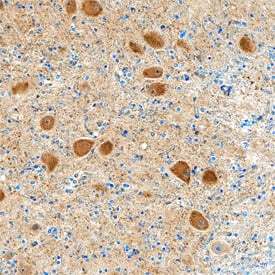Human Hexokinase 1/2 Antibody
R&D Systems, part of Bio-Techne | Catalog # AF8178

Key Product Details
Species Reactivity
Human
Applications
Immunohistochemistry, Western Blot
Label
Unconjugated
Antibody Source
Polyclonal Rabbit IgG
Product Specifications
Immunogen
E. coli-derived recombinant human Hexokinase 1 and E. coli-derived recombinant human Hexokinase 2
Phe11-Ser917 and Phe11-Arg917
Accession # P19367 & P52789
Phe11-Ser917 and Phe11-Arg917
Accession # P19367 & P52789
Specificity
Detects human Hexokinase 1 and human Hexokinase 2 in direct ELISAs and Western blots.
Clonality
Polyclonal
Host
Rabbit
Isotype
IgG
Scientific Data Images for Human Hexokinase 1/2 Antibody
Detection of Human Hexokinase 1/2 by Western Blot.
Western blot shows lysates of HeLa human cervical epithelial carcinoma cell line, K562 human chronic myelogenous leukemia cell line, and HEK293 human embryonic kidney cell line. PVDF membrane was probed with 1:1000 dilution of Rabbit Anti-Human Hexokinase 1/2 Antigen Affinity-purified Polyclonal Antibody (Catalog # AF8178) followed by HRP-conjugated Anti-Rabbit IgG Secondary Antibody (Catalog # HAF008). A specific band was detected for Hexokinase 1/2 at approximately 105 kDa (as indicated). This experiment was conducted under reducing conditions and using Immunoblot Buffer Group 1.Hexokinase 1/2 in Human Brain Medulla Tissue.
Hexokinase 1/2 was detected in immersion fixed paraffin-embedded sections of human brain medulla tissue using Rabbit Anti-Human Hexokinase 1/2 Antigen Affinity-purified Polyclonal Antibody (Catalog # AF8178) at 1:200 dilution overnight at 4 °C. Tissue was stained using the Anti-Rabbit HRP-DAB Cell & Tissue Staining Kit (brown; Catalog # CTS005) and counterstained with hematoxylin (blue). Specific staining was localized to neurons. View our protocol for Chromogenic IHC Staining of Paraffin-embedded Tissue Sections.Applications for Human Hexokinase 1/2 Antibody
Application
Recommended Usage
Immunohistochemistry
1:200 dilution
Sample: Immersion fixed paraffin-embedded sections of human brain medulla tissue
Sample: Immersion fixed paraffin-embedded sections of human brain medulla tissue
Western Blot
1:1000 dilution
Sample: HeLa human cervical epithelial carcinoma cell line, K562 human chronic myelogenous leukemia cell line, and HEK293 human embryonic kidney cell line
Sample: HeLa human cervical epithelial carcinoma cell line, K562 human chronic myelogenous leukemia cell line, and HEK293 human embryonic kidney cell line
Formulation, Preparation, and Storage
Purification
Antigen Affinity-purified
Formulation
Supplied as a solution in PBS containing BSA, Glycerol and Sodium Azide. See Certificate of Analysis for details.
Shipping
The product is shipped with polar packs. Upon receipt, store it immediately at the temperature recommended below.
Stability & Storage
Use a manual defrost freezer and avoid repeated freeze-thaw cycles.
- 12 months from date of receipt, -20 to -70 °C, as supplied.
- 1 month, 2 to 8 °C under sterile conditions after opening.
- 6 months, -20 to -70 °C under sterile conditions after opening.
Background: Hexokinase 1/2
References
1. Aleshin, A.E. et al. (1998) Structure 6:39-50
2. Takeda, J. et al. (1993) J. Biol. Chem. 268:15200.
3. Lange, A.J. et al. (1991) Biochem. J. 277:159–163.
4. Magnani, M. et al., J. Biol. Chem. 266: 502.
5. Nishi, S. et al. (1988) Biochem. Biophys. Res. Commun. 157:937.
6. Magnani, M. et al. (1992) Biochem. J. 285:193.
7. Van Wijk R. et al. (2003) Blood 101:345.
8. Wu, Z.L. (2011) PLoS One 6:e23172.
2. Takeda, J. et al. (1993) J. Biol. Chem. 268:15200.
3. Lange, A.J. et al. (1991) Biochem. J. 277:159–163.
4. Magnani, M. et al., J. Biol. Chem. 266: 502.
5. Nishi, S. et al. (1988) Biochem. Biophys. Res. Commun. 157:937.
6. Magnani, M. et al. (1992) Biochem. J. 285:193.
7. Van Wijk R. et al. (2003) Blood 101:345.
8. Wu, Z.L. (2011) PLoS One 6:e23172.
UniProt
Additional Hexokinase 1/2 Products
Product Documents for Human Hexokinase 1/2 Antibody
Product Specific Notices for Human Hexokinase 1/2 Antibody
* Contains <0.1% Sodium Azide, which is not hazardous at this concentration according to GHS classifications. Refer to SDS for additional information and handling instructions.
For research use only
